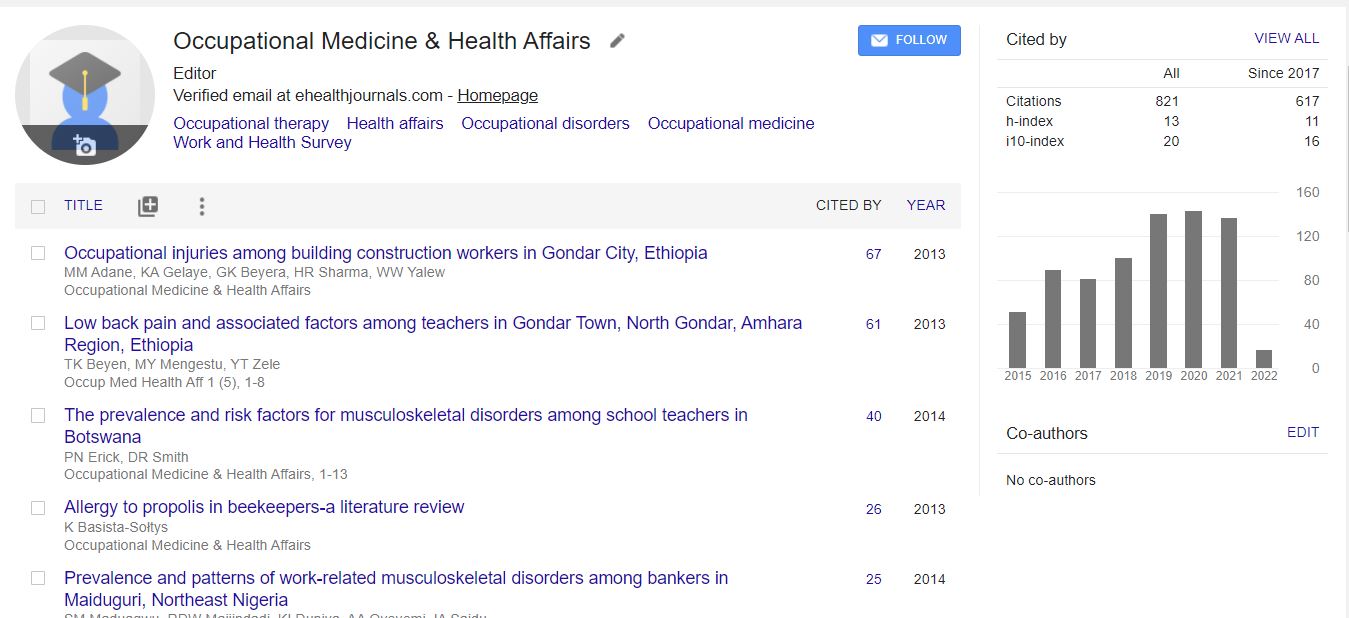Our Group organises 3000+ Global Conferenceseries Events every year across USA, Europe & Asia with support from 1000 more scientific Societies and Publishes 700+ Open Access Journals which contains over 50000 eminent personalities, reputed scientists as editorial board members.
Open Access Journals gaining more Readers and Citations
700 Journals and 15,000,000 Readers Each Journal is getting 25,000+ Readers
Google Scholar citation report
Citations : 1907
Occupational Medicine & Health Affairs received 1907 citations as per Google Scholar report
Indexed In
- Index Copernicus
- Google Scholar
- Open J Gate
- Academic Keys
- China National Knowledge Infrastructure (CNKI)
- RefSeek
- Hamdard University
- EBSCO A-Z
- OCLC- WorldCat
- Publons
- Geneva Foundation for Medical Education and Research
- Euro Pub
- Geneva Foundation for Medical Education and Research
- ICMJE
Useful Links
Recommended Journals
Related Subjects
Share This Page
MEASUREMENTS OF OCTANOL-AIR PARTITION COEFFICIENTS, VAPOR PRESSURES AND VAPORIZATION ENTHALPIES OF THE (E) AND (Z) ISOMERS OF THE 2-ETHYLHEXYL 4-METHOXYCINNAMATE AS PARAMETERS OF ENVIRONMENTAL IMPACT ASSESSMENT
International Conference on Environmental Health & Safety
Malisa S. Chiappero
Universidad Nacional de Mar del Plata, Argentina
ScientificTracks Abstracts: Occup Med Health Aff
Abstract
The 2-Ethylhexyl 4-methoxycinnamate, EHMC, is one of the UVB blocking agents more widely used in a variety of industrial fields given an enormous annual consumption. Problems that arise due to the accumulation of this compound in nature should be taken into consideration. The exposition of EHMC to the UV radiation produces isomerization in the double bond, consequently two photoisomers can exist, as (Z) or (E). In order to explain their atmospheric fate, it is required quantitative information regarding about their partition into atmospheric particles, aerosols and water droplets, as well as their volatility. As is well known, the PL and KOA are useful descriptors of chemical mobility in the atmospheric environment. All these parameters are strongly influenced by temperature. The GC-RT technique was used in this work with the aim of determining the vapor pressure, enthalpies of vaporization and octanol�air partition coefficient, for the BBP, DOP, E- and Z-EHMC esters. The results have showed that Z-EHMC is almost five times more volatile than E-EHMC. Moreover, BBP, Z-EHMC and E-EHMC can be classified as substances with a relatively low mobility since they lie within the range of 8 < log KOA < 10 and -4 < log(P L/Pa) < -2, while DOP lies in the range of log KOA > 10 and log(P L/Pa) < -4, therefore, a low mobility can be expected. From these parameters, their particle-bound fraction and gas�particle partition coefficient were also derived.Biography
Malisa S. Chiappero has completed her PhD at the age of 28 years from Universidad Nacional de Córdoba (Argentina) and postdoctoral studies from Ford Motor Laboratories under direction of the Gustavo A. Argüello and Timothy Wallington, respectively. She is director of the LANIN Laboratories (UNMdP). She is founding member of the Argentina Society for Science and Environmental Technology, SACyTA. She has published more than 20 papers in reputed journals.
Email: mchiappero@mdp.edu.ar

 Spanish
Spanish  Chinese
Chinese  Russian
Russian  German
German  French
French  Japanese
Japanese  Portuguese
Portuguese  Hindi
Hindi 